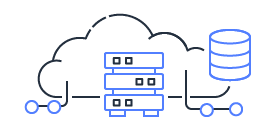Types of cloud computing
There are main three type of cloud computing.
- Infrastructure as a Service (IaaS)
- Platform as a Service (PaaS)
- Software as a Service (SaaS)
Infrastructure as a Service (IaaS)
Infrastructure as a Service (IaaS) is a business model that delivers IT infrastructure like compute, storage, and network resources on a pay-as-you-go basis over the internet. You can use IaaS to request and configure the resources you require to run your applications and IT systems. You are responsible for deploying, maintaining, and supporting your applications, and the IaaS provider is responsible for maintaining the physical infrastructure. Infrastructure as a Service gives you flexibility and control over your IT resources in a cost-effective manner.
For example, an e-commerce company gets three times more application traffic during the holiday season. To handle this traffic, they have to purchase additional server machines, which remain idle for the rest of the year. To overcome this challenge, cloud providers like AWS maintain highly secure data centers with a large volume of hardware devices. They give you access to this cloud computing infrastructure on a pay-as-you-go basis. You get flexible and secure access to practically unlimited resources so that you can meet all your business, legal, and compliance requirements.
Platform as a Service (PaaS)
Platforms as a service remove the need for organizations to manage the underlying infrastructure (usually hardware and operating systems) and allow you to focus on the deployment and management of your applications. This helps you be more efficient as you don’t need to worry about resource procurement, capacity planning, software maintenance, patching, or any of the other undifferentiated heavy lifting involved in running your application.
Software as a Service (SaaS)
Software as a Service provides you with a completed product that is run and managed by the service provider. In most cases, people referring to Software as a Service are referring to end-user applications. With a SaaS offering you do not have to think about how the service is maintained or how the underlying infrastructure is managed; you only need to think about how you will use that particular piece of software. A common example of a SaaS application is web-based email where you can send and receive email without having to manage feature additions to the email product or maintaining the servers and operating systems that the email program is running on.




.png)

0 Comments